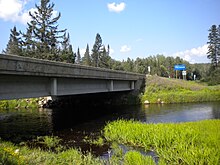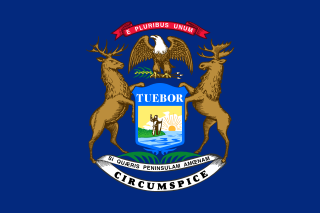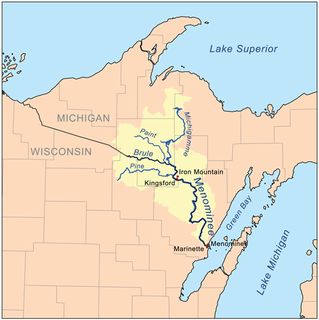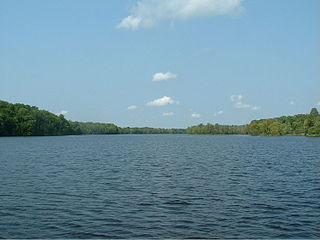This article needs additional citations for verification .(December 2011) (Learn how and when to remove this template message) |

The Brule River is a 52.3-mile-long (84.2 km) [1] river in the U.S. states of Michigan and Wisconsin. Nearly the entire course forms a portion of the boundary between the two states.

In the United States, a state is a constituent political entity, of which there are currently 50. Bound together in a political union, each state holds governmental jurisdiction over a separate and defined geographic territory and shares its sovereignty with the federal government. Due to this shared sovereignty, Americans are citizens both of the federal republic and of the state in which they reside. State citizenship and residency are flexible, and no government approval is required to move between states, except for persons restricted by certain types of court orders. Four states use the term commonwealth rather than state in their full official names.

Michigan is a state in the Great Lakes and Midwestern regions of the United States. The state's name, Michigan, originates from the Ojibwe word mishigamaa, meaning "large water" or "large lake". With a population of about 10 million, Michigan is the tenth most populous of the 50 United States, with the 11th most extensive total area, and is the largest state by total area east of the Mississippi River. Its capital is Lansing, and its largest city is Detroit. Metro Detroit is among the nation's most populous and largest metropolitan economies.

Wisconsin is a U.S. state located in the north-central United States, in the Midwest and Great Lakes regions. It is bordered by Minnesota to the west, Iowa to the southwest, Illinois to the south, Lake Michigan to the east, Michigan to the northeast, and Lake Superior to the north. Wisconsin is the 23rd largest state by total area and the 20th most populous. The state capital is Madison, and its largest city is Milwaukee, which is located on the western shore of Lake Michigan. The state is divided into 72 counties.
The Brule begins at Brule Lake, just inside the Michigan border, at 46°02′23″N88°50′59″W / 46.03972°N 88.84972°W . It winds east and southeast until joining with the Michigamme River at 45°57′12″N88°11′46″W / 45.95333°N 88.19611°W to form the Menominee River and on into Lake Michigan.
Brule Lake forms part of the border between the states of Michigan and Wisconsin and is the headwater of the Brule River at 46°02′23″N88°50′59″W.

The Michigamme River is a 67.0-mile-long (107.8 km) tributary of the Menominee River on the Upper Peninsula of Michigan in the United States. Via the Menominee River, its water flows to Lake Michigan.

The Menominee River is a river in northwestern Michigan and northeastern Wisconsin in the United States. It is approximately 116 miles (187 km) long, draining a rural forested area of northern Wisconsin and the Upper Peninsula of Michigan into Lake Michigan. Its entire course, with that of its tributary, the Brule River, forms part of the boundary between the two states.
The Brule River is stocked with many types of trout. These include Brook, and Brown trout[ citation needed ]
The Brule is popular for canoeing, spanning about 45 miles (72 km) with several stop/start points somewhat evenly spread out. The Brule's flow is much more reliable than many other surrounding rivers, due to its "untouched" quality.[ citation needed ] There is only one dam on the river that affects the water level, but that is located on Brule Island near the end of the Brule just below the Paint River.
Paint River is a 45.5-mile-long (73.2 km) river in the U.S. state of Michigan.
Much of the land on both sides of the river is publicly owned with several good campsites available. Fishing is exceptional, with brook and brown trout in the upper areas and tributaries. Smallmouth bass and northern pike can be found in abundance in the lower sections.






